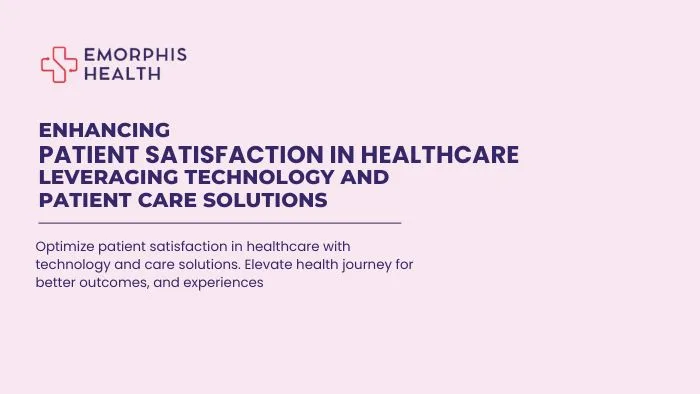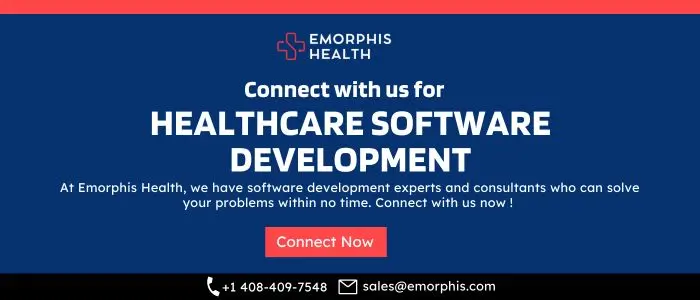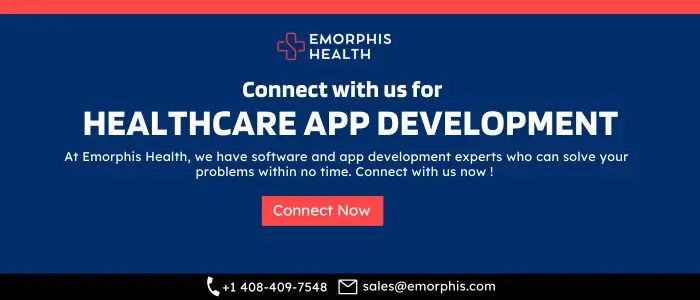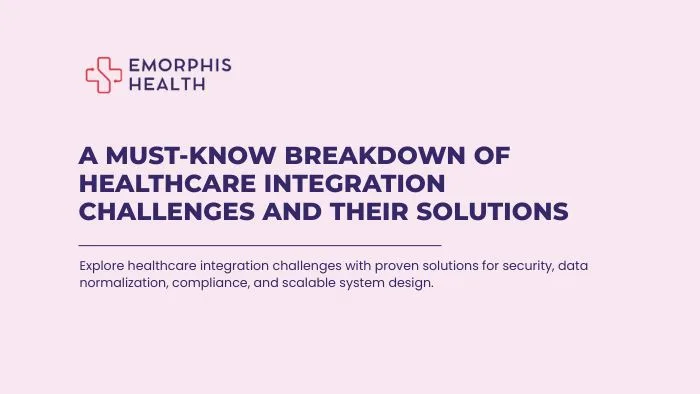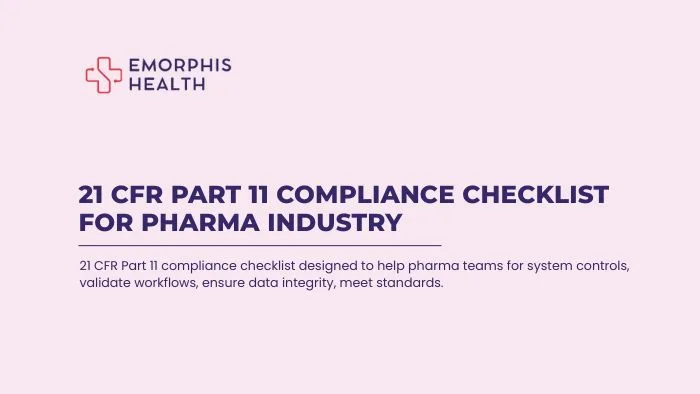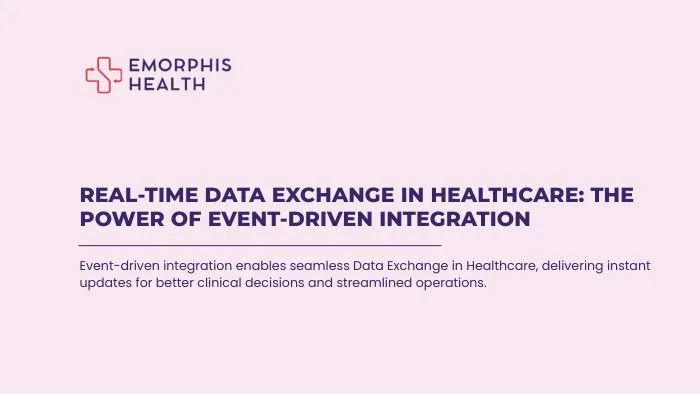What is patient satisfaction in healthcare?
See Contents
- 1 What is patient satisfaction in healthcare?
- 2 Why is patient satisfaction important?
- 3 How to measure patient satisfaction in healthcare?
- 4 Current Challenges in Patient Satisfaction in Healthcare
- 5 How can Technology Improve Patient Satisfaction in Healthcare?
- 6 How can patient care solutions help gain patient satisfaction in healthcare?
- 7 Conclusion
Patient satisfaction in healthcare is a multifaceted concept encompassing the overall contentment and fulfillment a patient experiences with the healthcare services they receive. It goes beyond just the medical treatment and includes factors such as effective communication with healthcare providers. Also, the timeliness of care, empathy displayed by the medical staff, and the general quality of the patient experience.
It reflects the patient’s perception of the care they received. Moreover, emphasizes the importance of a patient-centric approach in healthcare delivery. Also, ensuring patient satisfaction requires attention to various touchpoints along the patient journey. As a matter of fact, it is important to acknowledge the diverse needs and preferences of individuals seeking medical care.
Why is patient satisfaction important?
Patient satisfaction in healthcare holds paramount importance. In fact, it influences various facets of both patient outcomes and a healthcare provider’s reputation. Satisfied patients are more likely to adhere to treatment plans, also follow medical advice, and actively participate in their healthcare journey. Moreover, this, in turn, contributes to better health outcomes and reduced instances of non-compliance.
From a healthcare organization or provider’s perspective, positive patient experiences often translate into glowing online reviews and testimonials. Also, a strong reputation is instrumental in improving trust in healthcare providers. Happy patients are also more likely to recommend a provider, fostering organic growth in referrals and attracting a broader audience to the provider’s online platforms.
Latest statistics on patient satisfaction, experience in healthcare
In a recent survey conducted by Accenture, it was revealed that only one in three healthcare consumers has never encountered a negative experience with a healthcare provider, pharmacy, or hospital. Also, disturbingly, 44% of respondents who did report negative experiences expressed feelings of stress or upset regarding those encounters.
Another significant finding from Accenture’s survey is that half of healthcare consumers believe that a single unfavorable digital experience has the potential to tarnish their entire perception of a healthcare provider. Additionally, 39% of surveyed individuals emphasized the substantial impact of positive digital interactions on the overall patient experience.
PatientPop report sheds light on patient expectations, revealing that 57% of patients anticipate automated notifications via text, voice, or email to remind them of appointments or medication schedules. Furthermore, a considerable 70% of patients indicate that their choice of healthcare provider is influenced by the provider’s use of email or text message reminders for preventative or follow-up care.
Wait times at the doctor’s office emerge as a critical aspect of the patient experience, with 84% of healthcare consumers deeming it either “somewhat important” or “very important.” According to PatientPop, 43% of patients identify long wait times as the most frustrating aspect of healthcare appointments. Alarmingly, 30% have left appointments prematurely, and 20% have switched providers due to extended wait times.
How to measure patient satisfaction in healthcare?


Measuring patient satisfaction in healthcare involves employing diverse tools and methodologies to capture the nuances of the patient experience. Online surveys, often distributed through a provider’s website or patient portals, moreover, allow healthcare organizations to gather quantitative data on specific aspects of care.
As a matter of fact, qualitative insights can be obtained from third-party review platforms, social media, and online forums where patients share their experiences openly. Analyzing these comments and reviews provides valuable feedback on strengths and areas for improvement.
Strategies aligned with patient satisfaction in healthcare measurement involve optimizing online platforms to encourage positive patient reviews and testimonials. Moreover, integrating patient feedback into website content and leveraging it for marketing purposes contributes to building a robust online reputation that positively influences search engine rankings. In essence, measuring patient satisfaction in healthcare is a holistic approach that combines quantitative and qualitative data. Moreover, leveraging the power of patient feedback to enhance both the patient experience and the online presence of healthcare providers.
Let’s look out for the present obstacles in achieving patient satisfaction in healthcare.
Current Challenges in Patient Satisfaction in Healthcare
Patient satisfaction in healthcare stands as a cornerstone for quality care delivery. However, the road to ensuring high levels of patient satisfaction is not without its challenges. Identifying and addressing these issues is crucial for healthcare providers looking to enhance the overall patient experience and build a positive reputation. Let’s delve into the current challenges in patient satisfaction in healthcare and explore their impact on providers.
Identifying Common Issues
One of the primary challenges in ensuring patient satisfaction in healthcare is identifying the common issues that contribute to dissatisfaction. In fact, these issues can range from communication gaps and lengthy waiting times. Also, to the concerns about the quality of healthcare services offered and care provided. As a matter of fact, understanding the root causes requires a comprehensive approach. Involving feedback mechanisms, surveys, and also, open communication channels with patients. The intricacies of patient dissatisfaction often lie in unmet expectations which can be addressed. Overall, healthcare providers must proactively seek insights into the details and also look into addressing these concerns.
Impact on Healthcare Providers
The repercussions of low patient satisfaction in healthcare extend beyond individual experiences to impact the healthcare providers themselves. Negative patient experiences can lead to a tarnished reputation, affecting online reviews and overall public perception. In today’s digital age, where online presence significantly influences consumer choices, low patient satisfaction scores can adversely affect a healthcare provider’s search engine rankings and online visibility. Consequently, this can result in decreased patient trust, reduced referrals, and challenges in attracting new patients.
Moreover, dissatisfied patients are more likely to seek alternative healthcare providers, contributing to patient churn. This turnover not only impacts revenue but also creates a strain on the healthcare system, as resources are diverted to attracting and retaining patients. The financial implications of low patient satisfaction in healthcare underscore the importance of addressing challenges promptly and implementing strategies to enhance the overall patient experience.
Overall, the identification and resolution of current challenges in patient satisfaction are pivotal for healthcare providers aiming to excel in patient-centered care. By understanding common issues and their impact, providers can implement targeted strategies, improve communication, and elevate the quality of services, ultimately fostering a positive patient experience. As patient satisfaction in healthcare continues to be a key performance indicator, providers must embrace proactive measures to ensure the well-being of their patients and the success of their healthcare practices.
Now let’s check the role of technology in improving patient satisfaction in healthcare.
How can Technology Improve Patient Satisfaction in Healthcare?


Technology integration plays a pivotal role in enhancing patient satisfaction in healthcare and optimizing the overall healthcare patient journey. Patient care solutions, driven by technological advancements, have become instrumental in shaping a positive healthcare patient experience. Let’s explore how these solutions, focused on patient satisfaction in healthcare, are revolutionizing the delivery of care and transforming the healthcare patient journey.
1. Telehealth Solutions: Revolutionizing Accessibility and Convenience
- Enhanced Accessibility: Patient care solutions, particularly telehealth platforms, have broken down geographical barriers, allowing patients to access healthcare services conveniently from their homes. This improved accessibility contributes to a seamless healthcare patient journey.
- Reduced Wait Times: Through virtual consultations, patients experience reduced waiting times, leading to increased satisfaction. The immediacy of telehealth services enhances the overall healthcare patient experience by providing timely access to medical professionals.
2. Health Information Portals: Empowering Patients Through Information
- Transparent Healthcare Journey: Health information portals and electronic health records empower patients with direct access to their medical information, fostering transparency throughout the healthcare patient journey. This transparency contributes to a positive healthcare patient experience by keeping patients informed about their treatment plans and progress.
- Active Patient Engagement: Patient care solutions emphasize active patient engagement through these portals, ensuring that patients actively participate in their healthcare decisions. This involvement contributes to higher patient satisfaction in healthcare as individuals feel more in control of their care journey.
3. Mobile Apps for Holistic Patient Engagement
- Comprehensive Appointment Management: Patient care solutions extend to mobile apps, providing features such as appointment reminders, medication alerts, and personalized health tracking. These apps enhance the healthcare patient journey by streamlining administrative processes, reducing missed appointments, and promoting a proactive approach to healthcare.
- Tailored Health Tracking: The inclusion of personalized health tracking features in mobile apps allows patients to monitor their health metrics, fostering a holistic approach to wellness. This personalized care contributes to a positive healthcare patient experience and increased patient satisfaction in healthcare organizations.
Find details of Healthcare App Development
4. Artificial Intelligence (AI) Personalization for Tailored Care Plans
- Predictive Analytics: Patient care solutions leverage AI-driven technologies, including predictive analytics, to offer tailored care plans based on individual patient data. This personalization enhances the effectiveness of treatments, contributing to positive health outcomes and increased patient satisfaction in healthcare organizations.
- Efficient Processes: Machine learning algorithms within these solutions contribute to more efficient healthcare processes, reducing wait times and optimizing resource allocation. This efficiency positively influences the healthcare patient experience.
5. Virtual Reality (VR) for Enhanced Patient Comfort
- Improved Patient Comfort During Procedures: Patient care solutions explore the integration of virtual reality (VR) to improve patient comfort during medical procedures. VR technology offers immersive experiences that distract patients from pain and anxiety, contributing to a more positive healthcare patient experience and increased patient satisfaction.
6. Automated Appointment Scheduling and Reminders
- Streamlined Administrative Processes: Patient care solutions facilitate automated appointment scheduling systems, streamlining administrative processes. This contributes to operational efficiency, reducing administrative burdens on both healthcare providers and patients, and enhancing the overall healthcare patient journey.
- Enhanced Patient Engagement: Automated reminders, integrated into patient care solutions, ensure that patients stay informed about their upcoming appointments. This not only reduces the likelihood of missed appointments but also enhances patient engagement and satisfaction.
7. Remote Monitoring Devices for Proactive Health Management
- Real-time Health Monitoring: Wearable devices and remote monitoring technologies enable healthcare providers to monitor patients’ vital signs and health metrics in real-time. This proactive approach to health management allows for early intervention, better management of chronic conditions, and increased patient satisfaction in healthcare organizations.
- Empowering Patients: Patient care solutions that incorporate remote monitoring devices empower patients to actively participate in their health management. The continuous flow of health data fosters a sense of control, contributing to a positive healthcare patient experience.
Find details of Remote patient monitoring
8. Patient Feedback Mechanisms
- Continuous Quality Improvement: Patient care solutions include feedback mechanisms such as online surveys and review platforms. This continuous collection of patient feedback allows healthcare providers to identify areas for improvement, demonstrating a commitment to quality care and positively influencing patient satisfaction in healthcare organizations.
- Transparent Communication: Actively seeking and responding to patient feedback through these solutions fosters transparent communication between healthcare providers and patients, enhancing trust and overall satisfaction in the healthcare patient journey.
9. Chatbots for Instant Patient Support
- Accessible Healthcare Information: Patient care solutions may integrate chatbots to provide instant responses to patient queries. This accessibility to healthcare information contributes to a positive healthcare patient experience by offering quick and reliable support.
- 24/7 Availability: The availability of chatbots around the clock ensures that patients can access information whenever they need it. This instant support adds to the overall convenience and satisfaction of the healthcare patient journey.
10. Integration of Social Determinants of Health
- Comprehensive Healthcare Approach: Patient care solutions are evolving to integrate social determinants of health, considering factors such as socio-economic conditions and environmental influences. This comprehensive approach acknowledges the holistic nature of patient well-being, contributing to a more personalized and satisfying healthcare patient experience.
- Tailored Interventions: By considering social determinants, healthcare providers can tailor interventions and support systems, addressing underlying factors that may impact a patient’s health. This personalized care approach positively influences patient satisfaction.
Overall, patient care solutions driven by technology are instrumental in optimizing the healthcare patient journey, enhancing the overall healthcare patient experience, and ultimately leading to increased patient satisfaction in healthcare. As technology continues to evolve, healthcare providers can leverage these solutions to provide patient-centered care and foster a positive healthcare environment.
Now, let us look at in what ways can patient care solutions contribute to achieving patient satisfaction in the healthcare sector.
How can patient care solutions help gain patient satisfaction in healthcare?


Patient care solutions play a crucial role in improving patient satisfaction by addressing various aspects of healthcare delivery. Here are ways in which patient care solutions can contribute to enhancing patient satisfaction:
A. Improved Communication for patient satisfaction in healthcare
- Secure Messaging Systems: Patient care solutions often include secure messaging platforms that enable direct communication between patients and healthcare providers. This facilitates quick and easy communication, leading to better understanding and satisfaction.
B. Efficient Appointment Management
- Online Scheduling: Patient care solutions may offer online appointment scheduling, allowing patients to book and manage appointments at their convenience. This reduces waiting times and enhances the overall patient experience.
C. Access to Health Information
- Health Portals: Patient care solutions can provide patients with access to their medical records, test results, and treatment plans through health portals. Empowering patients with information promotes transparency and fosters trust.
D. Remote Monitoring and Telehealth
- Telehealth Services: Patient care solutions that incorporate telehealth services enable remote consultations and monitoring. This is particularly beneficial for patients with chronic conditions, reducing the need for frequent in-person visits and improving access to care.
E. Personalized Care Plans for patient satisfaction in healthcare
- Healthcare Apps: Patient care solutions often include mobile apps that offer personalized care plans. These apps can provide patients with reminders for medication, exercise, and lifestyle modifications, leading to improved adherence and satisfaction.
F. Swift Access to Services
- Virtual Triage: Patient care solutions can include virtual triage systems that assess the urgency of a patient’s condition. This ensures that patients receive timely attention, reducing frustration and improving overall satisfaction.
G. Enhanced Patient Education
- Interactive Content: Patient care solutions may integrate interactive educational content, such as videos and multimedia resources, to educate patients about their conditions and treatment options. Informed patients are generally more satisfied with their care.
H. Feedback Mechanisms for patient satisfaction in healthcare
- Surveys and Feedback Tools: Patient care solutions often include features for collecting patient feedback. This enables healthcare providers to assess patient satisfaction, identify areas for improvement, and demonstrate a commitment to continuous enhancement of services.
I. Reduced Waiting Times
- Digital Check-In Systems: Patient care solutions leverage digital check-in systems, streamlining registrations to minimize waiting room times. This boosts operational efficiency and ensures a positive patient experience, enhancing satisfaction with reduced delays and a more patient-centric healthcare approach.
J. Proactive Health Management
- Remote Monitoring Devices: Integrating patient care solutions with remote monitoring devices allows healthcare providers to proactively manage patients’ health conditions. Early detection and intervention can lead to improved outcomes and increased patient satisfaction.
K. Empathy and Support for patient satisfaction in healthcare
- Virtual Support Services: Patient care solutions may include virtual support services, such as chatbots or virtual assistants, providing patients with instant answers to common questions and offering emotional support.
By incorporating these elements into patient care solutions, healthcare providers can significantly contribute to enhancing patient satisfaction and overall engagement in their healthcare journey.
Conclusion
In conclusion, the symbiosis of technology and patient care solutions represents a paradigm shift in healthcare, fostering a patient-centric environment. By optimizing accessibility, personalization, and efficiency, these innovations elevate the overall patient experience, thereby contributing significantly to enhanced satisfaction and the continual evolution of healthcare delivery.
Our healthcare software product engineering services aim to revolutionize the patient healthcare journey by leveraging innovative technologies. We recognize the critical role that well-designed software plays in enhancing patient satisfaction. Through customized solutions, we address various aspects of healthcare, from seamless appointment scheduling and electronic health record management to intuitive patient-facing applications. Our approach is centered on creating user-friendly interfaces, ensuring data security, and optimizing workflow efficiency. By adopting patient care solutions such as comprehensive care models, holistic wellness approaches, and collaborative care platforms, our software development endeavors seek to streamline processes, reduce wait times, and improve communication.
Ultimately, our goal is to contribute to a positive patient experience, fostering a healthcare environment where patients feel supported and engaged throughout their journey.

